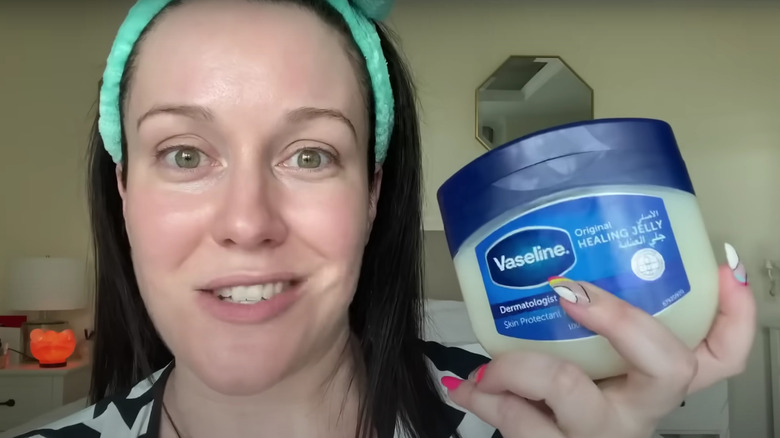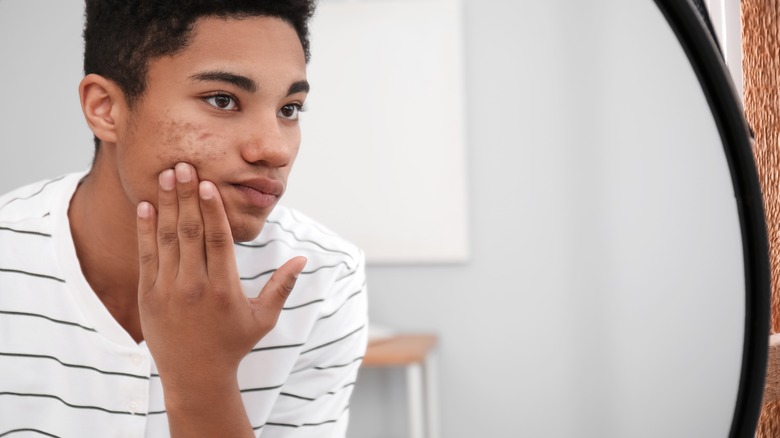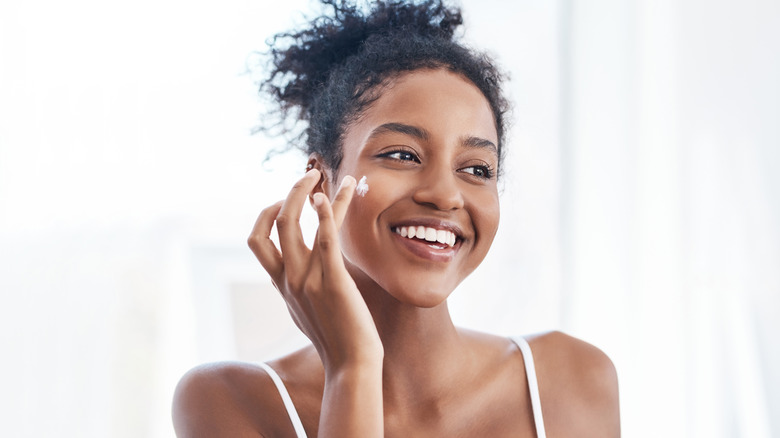FYI, The Viral Skin Slugging Technique Isn't For Everyone. Here's What We Know
Many of us are on the quest for healthy, radiant skin. This sentiment is reflected in the number of skincare products sold each year. The U.S. skincare market generates billions, bringing in a whopping $19 billion last year alone (via Statista). The sheer scale of products sold indicates the skincare market's ever-increasing popularity and reflects how many people want to keep their skin in good condition. Unsurprisingly, a large proportion of these sales come from the sales of moisturizers, which many of us, perhaps yourself included, use on a regular basis. However, it's not only traditional moisturizers that people use to keep their skin looking fresh.
While you may or may not have heard of it, a popular trend known as "slugging" is one fascinating hack many beauty lovers use to keep their skin juicy and moist. While using petroleum jelly instead of moisturizer can promise dreamy hydrated skin, it turns out that the technique may not be suitable for anyone. But why? As it turns out, those with oily skin may not benefit from this hack at all.
Slugging isn't good for individuals with acne
While the idea of "slugging" may seem like the perfect way to get radiant-looking skin, it may actually have the opposite effect. Speaking to the online-publication Good Housekeeping, board-certified dermatologist David Kim, M.D. explains which skin types should avoid the popular technique at all costs: "This is certainly not for anyone with acne-prone, oily skin or combination skin." He labels the reasoning behind that "you're trying to rebalance your skin," suggesting that the technique could hinder this process. Therefore if you use this technique with any of these skin types, you may actually be spelling out disaster for your skin. You should probably avoid pore strips too.
On the other hand, if you don't know your skin type, how do you know if you're an ideal candidate for slugging? If you're unsure about skin type, then there are some easy ways to identify it. First, you can always seek a professional opinion, either from a dermatologist or a doctor. However, if you want to figure it out from home, there is a simple way to do so. Speaking to Marie Claire, skincare expert Fiona Brackenbury recommends that you "cleanse your skin and [leave it alone] for 30 minutes without applying any skincare. No toners, essences, serums, or moisturizer. After half an hour, you will be able to observe the level of oil the skin has produced." If you're still unsure after this, then you may want to seek advice in-store or from a professional.
Choose a product suitable for your skin type
If you're disappointed that you can't try slugging, hope isn't lost. In fact, there are plenty of great alternatives that you can try. So, what can you do? Instead, your best bet to achieve hydrated skin is to find products that are specifically recommended for your skin type. Choosing what's right will help to hydrate it without aggravating the rest of your skin. Of course, you could always check out any online alternatives to "slugging" too. However, you should always make sure to research if the product will be a good fit for your skin type before taking the plunge. After all, you don't want your hard-earned pennies thrown down the drain.
Speaking to Evening Standard, consultant dermatologist Dr. Alexis Granite recommends "moisturizing ingredients such as hyaluronic acid, ceramides, and glycerin [for] oily skin." In addition, she also recommends "retinol, salicylic acid, and niacinamide, all of which are especially good if you are prone to breakouts." If you experience acne after coming off birth control, there are some great ways to manage it. Now you're aware of some great alternatives, you should be able to pull the plug on the "slugging" hack once on for all. In addition, you should also ensure that you do your due diligence regarding future hacks. This way, you'll always do what is best for your skin.


